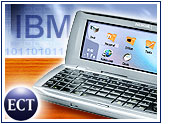
IBM and Nokia have unveiled the latest 9500 Communicator — a BlackBerry-like handheld capable of running IBM and other enterprise office software applications on Nokia’s Symbian operating system.
There is little doubt about the viability of Nokia-controlled Symbian — a rival to Palm OS, Microsoft’s Windows CE and embedded Linux — for all types of applications, including those designed for high-end corporate use, but the new device likely is an effort to brighten its future, especially in the United States.
Forrester analyst Charles Golvin told TechNewsWorld that Symbian, which began as a multi-company effort to prevent Microsoft’s mobile operating system from achieving market gains, is not necessarily going to emerge triumphant as vendors seek to hedge their bets by supporting multiple operating systems.
“Most of these players — [including] Motorola and Samsung, who is a small stakeholder in Symbian — are coming out with every manner of OS,” Golvin said, referring to Palm, Windows and Linux. “Nokia’s the only one not really following the hedging strategy.”
In other words, by betting solely on Symbian, Nokia appears to be taking a relatively risky position.
Beefing Up ‘The Brick’
The Nokia 9500 Communicator, a device previously dubbed “The Brick” because of its size and heft, features two small color displays and a QWERTY keyboard. It is 5.8 inches tall, 2.25 inches wide and 0.9 millimeters thick, with a weight of 7.8 ounces — nearly half a pound.
More importantly, the converged mobile phone and PDA delivers tri-band, five-continent, high-speed wireless connectivity via the EDGE (Enhanced Data Rates for GSM Evolution) standard, as well as wireless LAN access. It runs Symbian 7.0 and can support e-mail, word processing, spreadsheet and other business applications, including IBM’s WebSphere, Tivoli and instant messaging software.
The 9500 Communicator, which also features Bluetooth and Pop-Port interfaces, is expected to become available in the fourth quarter of 2004, Nokia said.
Enterprise Hurdles
IDC smart handheld devices analyst Alex Slawsby told TechNewsWorld that although the new Communicator offers unparalleled mobile computing capability, the same issues that plagued previous versions of the device — problems of size and price — remain.
“It offers by far the most functionality virtually possible in a phone,” Slawsby said. “It still is a big phone, though.” He compared the 7.8-ounce 9500 Communicator to Nokia’s 7210 smartphone, which weighs nearly two-thirds less at 2.9 ounces.
Slawsby added that an earlier effort by Nokia to sell the Communicator, which was originally a consumer device, in the enterprise did not succeed. Now, with its latest improvements, the device may be more suited to the top-of-the line enterprise market, but with a price tag of about US$900, it will be competing with cheaper, smaller smartphones.
Showing Off Symbian
For his part, Yankee Group program manager Roger Entner told TechNewsWorld that the 9500 Communicator is less of a consumer or corporate product than it is a demonstration of Symbian, which historically has been popular in Europe while the Palm OS has dominated in the United States.
“They want to show everybody what Symbian can do, and this is certainly a piece of it,” Entner said.
IDC’s Slawsby echoed Forrester’s Golvin in saying that most mobile-device makers are embracing a diversity of operating systems. Even IBM, Nokia’s partner in rolling out the Communicator, recently reiterated its commitment to a range of devices on multiple operating systems.
“IBM realizes that to be successful in the world of mobile computing, it has to be OS agnostic,” Slawsby said.
The analyst, who anticipates some interesting competition as Nokia pushes Symbian toward the enterprise market and as Microsoft partners HP and Dell respond, called the mobile OS battle “an interesting clash of the titans.”











































